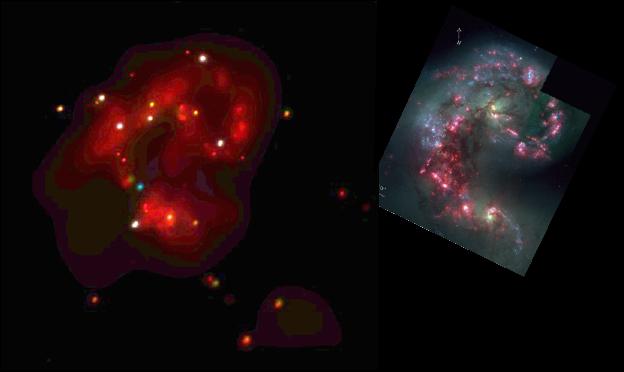
 Credit: X-ray (left): NASA/SAO/G.Fabbiano et al.; Optical (right): NASA/HST/Whitmore et al.
Credit: X-ray (left): NASA/SAO/G.Fabbiano et al.; Optical (right): NASA/HST/Whitmore et al.
Xray image of a Cosmic Crash
The average relative distance between any two stars in a galaxy is much
larger than the size of the stars themselves, meaning stellar collisions
are exceedingly rare. However, the average distance between any two
galaxies is not that much greater than the size of the galaxies, so that
collisions between galaxies are not uncommon. A famous example of a
galactic collisions is the Antennae. Now Chandra has obtained an X-ray image of
the crash site. The image on the above left is a "true" color image of
the Antennae by the Chandra ACIS camera, in which the color of the
sources represents the energy of the x-ray emission: red represents the low
energy band, green intermediate and blue the highest observed energies. The
white and yellow sources are those that emit significant amounts of both
low- and high-energy X-rays. The point sources are so-called
"superluminous" sources, which may either be mid-mass black holes (black
holes with a mass of perhaps a few hundred solar masses) or black holes
whose emission is "beamed" preferentially in our direction. The image on
the right is an image of the crash site from the Hubble Space Telescope. In
the Hubble image most of the emission is produced by bright star forming
"knots", which probably represent stellar nurseries where star formation
was "triggered" by the collision. Note that, even in such galactic
collisions, the chances of a collision between individual stars in the
galaxies is vanishingly small.
Last Week *
HEA Dictionary * Archive
* Search HEAPOW
* Education
Each week the HEASARC
brings you new, exciting and beautiful images from X-ray and Gamma ray
astronomy. Check back each week and be sure to check out the HEAPOW archive!
Page Author: Dr. Michael F.
Corcoran
Last modified July 30, 2001


